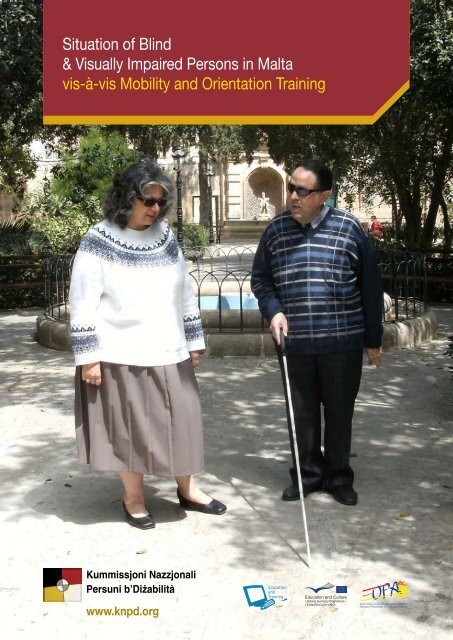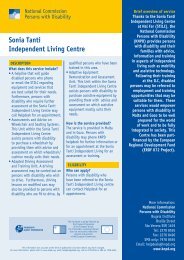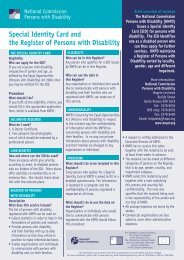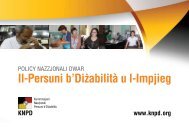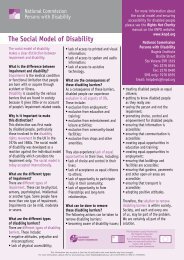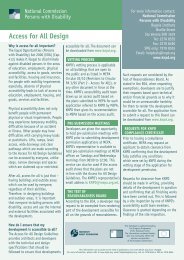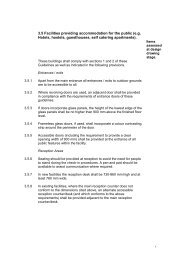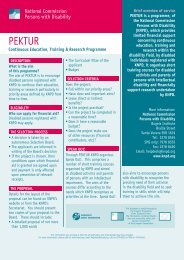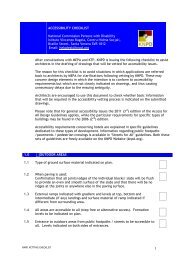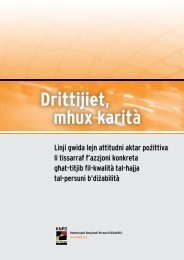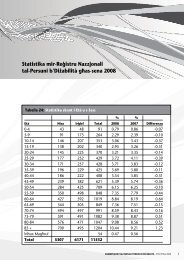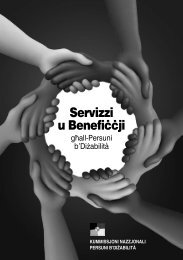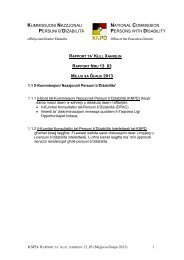KNPD visual report.pdf
KNPD visual report.pdf
KNPD visual report.pdf
You also want an ePaper? Increase the reach of your titles
YUMPU automatically turns print PDFs into web optimized ePapers that Google loves.
Situation of Blind<br />
& Visually Impaired Persons in Malta<br />
vis-à-vis Mobility and Orientation Training<br />
Kummissjoni Nazzjonali<br />
Persuni b’DiΩabilità<br />
www.knpd.org
Editors: J Camilleri, A Zammit<br />
Publication:<br />
Kummissjoni Nazzjonali Persuni b’DiΩabilità<br />
Çentru Óidma Soçjali, Istitut Vincenzo Bugeia, Santa Venera<br />
Telephone: 2278 8555<br />
Fax: 2278 8490<br />
SMS only: 7978 8555<br />
Email: helpdesk@knpd.org<br />
www.knpd.org<br />
ISBN: 978-99909-71-46-0<br />
© Kummissjoni Nazzjonali Persuni b’DiΩabilità - 2010<br />
This publication has been funded with the support of the European Commission.<br />
This publication reflects the views only of the author, and the Commission cannot be<br />
held responsible for any use which may be made of the information contained therein.
Introduction<br />
Methodology<br />
Blind and <strong>visual</strong>ly impaired persons<br />
perceive the world differently from sighted<br />
persons. Mobility and Orientation Training<br />
(MOT) can increase the independence<br />
and quality of life of blind and <strong>visual</strong>ly<br />
impaired persons, as they would be<br />
able to participate more actively in their<br />
community. There is currently no MOT<br />
service in Malta.<br />
The Mobility and Orientation for Blind and<br />
Visually Impaired Persons (MOBAVIP)<br />
Project is a part-funded EU project aimed<br />
at transferring the innovation of MOT to<br />
the Maltese Islands. The project includes a<br />
study on the situation of blind and <strong>visual</strong>ly<br />
impaired persons vis-à-vis MOT in Malta.<br />
A questionnaire consisting of thirteen (13)<br />
questions was sent out to a representative<br />
sample of five hundred (500) individuals<br />
registered as blind or <strong>visual</strong>ly impaired<br />
persons with <strong>KNPD</strong>. The questionnaire<br />
(see appendix A) was designed by <strong>KNPD</strong><br />
with the assistance of Provision Solutions<br />
which is one of the partner organisations<br />
in the MOBAVIP project. The sample was<br />
extracted according to the gender, age<br />
and district (location) of the population<br />
of mobility and <strong>visual</strong>ly impaired persons<br />
registered in the <strong>KNPD</strong> database. Out<br />
of the five hundred (500) questionnaires<br />
sent out, hundred and thirty (130) persons<br />
completed the questionnaires. This<br />
amounts to a response rate of 26%, which<br />
is considered as an average response rate.<br />
In order to gain more information about<br />
what blind and <strong>visual</strong>ly impaired persons<br />
think and know about MOT, a questionnaire<br />
was sent out to a sample of persons<br />
registered as blind or <strong>visual</strong>ly impaired with<br />
the National Commission Persons with<br />
Disability (<strong>KNPD</strong>).<br />
3
Results and Analysis<br />
PART 1:<br />
Demographics<br />
Gender<br />
Out of 130 respondents, 64 of them,<br />
equalling to 49% of the total respondents,<br />
were men. The remaining 66 persons,<br />
that is 51% of the total respondents, were<br />
women. The difference between male and<br />
female respondents is very slight. The<br />
gender of the respondents is represented<br />
in a pie chart, Figure 1 found in Appendix<br />
B.<br />
Age<br />
• 3 out of the 130 respondents were<br />
aged between zero (0) and 9 years –<br />
2.3%.<br />
• 2 respondents were aged from 10 to 19<br />
years of age – 1.5%.<br />
• Another 2 persons were aged between<br />
20 to 29 years – 1.5%.<br />
• 15 respondents were 30 to 39 years old<br />
– 11.5%.<br />
• 20 respondents had 40 to 49 years of<br />
age – 15.4%.<br />
• 21 of the respondents were aged<br />
between 50 to 59 years old – 16.2%.<br />
• 18 respondents had 60 to 69 years of<br />
age – 13.9%.<br />
• 30 persons were between 70 to 79<br />
years old – 23.1%.<br />
• 15 were between 80 to 89 years of age<br />
– 12%.<br />
• 4 respondents were aged over 90 –<br />
3.1%.<br />
The percentages above have been worked<br />
out by age categories and this is the<br />
reason why the total of the percentages<br />
amounts to more than 100%.<br />
This information is represented in a bar<br />
chart, figure 2 found in Appendix B.<br />
The largest age group of respondents<br />
were aged between 70 to 79 years of age<br />
at 23.1% of the total respondents. The<br />
second largest category is that between<br />
50 – 59 years of age, amounting to 16.2%<br />
of the total respondents.<br />
Visual impairment is likely to increase with<br />
age. Consequently elderly persons would<br />
be more likely to require MOT.<br />
4
Education<br />
• 41.5%, (54 respondents) said that they<br />
frequented school up to primary level of<br />
education.<br />
• 37.7%, (49 respondents) said that they<br />
completed up to secondary school.<br />
• 8.5% (11 respondents) frequented<br />
post-secondary schooling.<br />
• 9.2% (12 respondents) completed<br />
tertiary education.<br />
• 3.1% (4 respondents) said that they<br />
received no education at all.<br />
The above information is represented in a<br />
bar chart, Figure 3 found in Appendix B.<br />
This shows that almost the majority of the<br />
respondents received only primary level<br />
education. The second largest category<br />
is that of persons that received up to<br />
secondary level education. Together<br />
these categories make up to 79.2% of<br />
the total respondents. Only 17.7% of the<br />
total respondents have received postsecondary<br />
or tertiary education.<br />
3.1% (4 persons) out of the total<br />
respondents claim that they never<br />
frequented school at all. Three of these<br />
respondents are aged over 78 years, but 1<br />
person who says that he never frequented<br />
school is 43 years of age.<br />
Employment<br />
• 3.1% (4 persons) said that at present<br />
they are full-time students.<br />
• 1.5% (2 persons) said that they are parttime<br />
students.<br />
• 13.9% (18 respondents) said that they<br />
are employed on a full-time basis.<br />
• 1.5% (2 persons) said they are in parttime<br />
employment.<br />
• 3.9% (5 persons) are seeking<br />
employment.<br />
• 7.7% (10 persons) are attending day<br />
centres.<br />
• 55.4% (72 persons) are retired.<br />
• 13.1% (17 persons) chose the category<br />
‘others’. Out of these 17, 10.7% said that<br />
they were housewives and the remaining<br />
2.3% said that they live in an institution.<br />
The above information is represented in a<br />
pie chart, Figure 4 found in Appendix B.<br />
The majority of the respondents, that is<br />
55.4%, are retired. The second largest<br />
category is that of full-time students. The<br />
ages of full-time students range between 3<br />
to 7 years of age, meaning that all of them<br />
are in primary education.<br />
The persons seeking employment are all<br />
aged between 32 and 57 years of age, of<br />
whom 3 are male and 2 are females.<br />
5
PART 2:<br />
What do respondents<br />
think of MOT<br />
The questions in this part were aimed at<br />
gathering information on whether blind<br />
and <strong>visual</strong>ly impaired persons in Malta are<br />
aware of what MOT is, whether they think<br />
such training would be of benefit to them,<br />
and what obstacles and needs they think<br />
should be addressed before they could<br />
engage in MOT.<br />
Question No. 5:<br />
If you have lost your sight later on in<br />
life, describe the difficulties you are<br />
encountering to travel and how these<br />
can be overcome<br />
The following question is aimed at<br />
gathering information on what are the<br />
obstacles that blind and <strong>visual</strong>ly impaired<br />
persons encounter when travelling from<br />
one place to another. The respondents<br />
mentioned a number of obstacles that<br />
hinder them when travelling. Respondents<br />
could mention more than one obstacle.<br />
• 26.2% (34 respondents) did not answer<br />
this question and did not mention any<br />
obstacles that they encounter in their<br />
everyday lives.<br />
• 0.8%, (1 respondent) said that he<br />
encounters no obstacles in going from<br />
one place to the other, claiming that<br />
the reason behind this is that he has a<br />
guide dog.<br />
• 4.6% (6 respondents) said that they<br />
never leave their house at all.<br />
• 36.9% (48 respondents) said that they<br />
never go out of their house alone and<br />
that they are always accompanied by<br />
another person when they need to go<br />
from one place to another.<br />
Of those respondents who do go out:<br />
• 18.5% (24 respondents) mentioned<br />
that streets are not accessible, in<br />
particular pavements were said to be<br />
considered as very dangerous due to<br />
the various items such as garbage bags<br />
and doorsteps in the way. This was<br />
the obstacle which was mentioned the<br />
most.<br />
• 10% (13 respondents) mentioned<br />
inaccessible public transport as an<br />
obstacle which deters them from being<br />
able to travel more independently.<br />
• 3.8% (5 respondents) said that the<br />
major obstacle encountered on the<br />
streets is traffic, as they are afraid of<br />
being run over by drivers.<br />
6
• 1.5% (2 respondents) said that not<br />
being trained in independent living skills<br />
constitutes an obstacle which deters<br />
them from being able to live a more<br />
independent life.<br />
The data above shows that most people<br />
do not leave their house unaccompanied<br />
and those who do go out and about do so<br />
with a number of difficulties.<br />
Question No. 6:<br />
Have you received any form of Mobility<br />
and Orientation Training in the past<br />
The respondents were asked whether they<br />
had received any form of MOT in the past.<br />
This question was aimed at gathering<br />
information on whether blind and <strong>visual</strong>ly<br />
impaired persons in Malta have received<br />
this kind of training in their life.<br />
Question No. 7:<br />
If you have received such training,<br />
which institution was providing it<br />
Those respondents who had answered<br />
yes to the previous question were asked<br />
to state which institution had provided the<br />
training in mobility and orientation.<br />
3 out of the 5 respondents who received<br />
MOT had done so in the United Kingdom.<br />
1 respondent said that he received some<br />
form of orientation training in a multisensory<br />
room at the Park of Friendship in<br />
Malta, while another respondent said that<br />
he was trained in MOT by the Malta Guide<br />
Dog Association.<br />
This indicates that there are currently<br />
limited opportunities for MOT in Malta.<br />
96.2% (125 respondents) said that<br />
they have never received mobility and<br />
orientation training in the past.<br />
3.8% (5 respondents) said that they have<br />
received MOT.<br />
From the data above it is clear that a very<br />
small percentage of respondents have<br />
been trained in Mobility and Orientation in<br />
the past.<br />
Question No. 8:<br />
And how do you feel that this training<br />
has been of benefit to you<br />
The 5 respondents who were trained in<br />
MOT commented on the effect that this<br />
training has had on their lives. Their<br />
comments were as follows:<br />
very beneficial<br />
•<br />
given some tips for everyday life<br />
•<br />
learnt all colours and orientated<br />
•<br />
himself better<br />
7
• became more independent<br />
• one of the respondents said that<br />
she had received MOT back in the<br />
United Kingdom when she was still<br />
in primary school. However, she is<br />
now too afraid to practise in Malta<br />
and always travels accompanied by<br />
another person.<br />
MOT can therefore be very beneficial<br />
although other factors (mentioned in<br />
question no. 5) may hinder <strong>visual</strong>ly<br />
impaired persons from practising it.<br />
so that the instructor can carry out an<br />
adequate assessment according to<br />
their real needs.<br />
• 0.8% (1 respondent) said that her role<br />
would be that of participating in MOT.<br />
• 0.8% (1 respondent) said that his<br />
role would be that of ensuring that<br />
all members of a particular nongovernmental<br />
organisation in Malta<br />
received MOT.<br />
The majority of respondents are unclear<br />
about what MOT entails.<br />
Question No. 9:<br />
What do you think your role would be<br />
in Mobility and Orientation Training<br />
Respondents were asked what they think<br />
that their role in MOT would be.<br />
• 69.2% (90 respondents) did not provide<br />
an answer to this question.<br />
• 8.5% (11 respondents) said that they do<br />
not know what their role in MOT would<br />
be.<br />
• 17.7% (23 respondents) said that their<br />
role in MOT would be that of trainees.<br />
• 1.5% (2 respondents) said that their role<br />
would be that of instructors/advisors.<br />
• 1.5% (2 respondents) said that their<br />
role would be that of providing all<br />
relevant information about themselves<br />
Question No. 10:<br />
What do you need to be able to do<br />
before undertaking Mobility and<br />
Orientation training<br />
The respondents were asked whether<br />
they could think of any needs that would<br />
have to be taken into consideration<br />
before they could engage in MOT.<br />
This question was aimed at gathering<br />
information on whether blind and <strong>visual</strong>ly<br />
impaired persons perceive any needs that<br />
they would have to address before being<br />
able to engage in MOT. The respondents<br />
could mention more than one need. The<br />
following are the replies received:<br />
• 56.92% (74 respondents) gave no<br />
answer to this question.<br />
8
• 18.5% (24 respondents) said that they<br />
did not know.<br />
• 3.1% (4 respondents) replied that they<br />
had no needs that had to be addressed<br />
before they could engage in MOT, and<br />
that they would be able to start the<br />
training right away.<br />
• 3.1% (4 respondents) said that they<br />
would need to learn more about what<br />
MOT entails as they feel that they<br />
do not have enough information with<br />
regards to what MOT entails.<br />
• 3.1% (4 respondents) said that they<br />
would need to be properly assessed by<br />
a Mobility and Orientation instructor.<br />
• 1.5% (2 respondents) said that they<br />
would need a medical check up before<br />
engaging in this training.<br />
• 1.5% (2 respondents) said that they<br />
would need personal assistance so that<br />
they could participate in the training.<br />
• 3.1% (4 respondents) said that<br />
they would need to be trained in<br />
communication skills prior to begin<br />
training in Mobility and Orientation.<br />
• 3.9% (5 respondents) said that they<br />
would first need to be trained in daily<br />
living skills so that they could first<br />
acquire the skills needed to get out of<br />
the house independently.<br />
• 3.9% (5 respondents) would need<br />
transport to get to the training venue<br />
• 0.8% (1 respondent) said that he would<br />
be able to participate in such training<br />
depending on the time at which the<br />
training sessions are delivered.<br />
• 0.8% (1 respondent) said that first a<br />
blind or <strong>visual</strong>ly impaired person would<br />
need to decide that s/he wants to<br />
become independent before actually<br />
deciding to embark on MOT.<br />
The data shows that most respondents<br />
required preparation before engaging in<br />
MOT.<br />
Question No. 11:<br />
Which of these form part of mobility<br />
and orientation training<br />
Answer Yes or No.<br />
This question was put forward to the<br />
respondents in order to gain a better<br />
understanding of whether blind and<br />
<strong>visual</strong>ly impaired persons are aware of<br />
what MOT is. Respondents were asked to<br />
answer with a ‘yes’ or a ‘no’ next to each<br />
item.<br />
White cane – 68 respondents out of 130<br />
said that the white cane makes part of<br />
MOT. This means that only 52.3% of the<br />
persons actually know that the white cane<br />
is a tool used as part of MOT.<br />
9
Sighted guide – 53 respondents said<br />
that sighted guide makes part of<br />
MOT amounting to 40.8% of the total<br />
respondents. Sighted guide actually<br />
makes part of MOT. The fact that only<br />
40.8% replied that it does means that the<br />
majority of respondents do not know that<br />
sighted guide makes part of MOT.<br />
Guide dogs – 49 respondents said that<br />
using a guide dog makes part of MOT,<br />
meaning that only 37.7% think that MOT<br />
also involves guide dogs as in fact it does.<br />
The rest of the respondents do not think<br />
that guide dogs make part of MOT.<br />
Taking care of guide dog – 30<br />
respondents, that is 23.08% said that<br />
MOT involves taking care of one’s guide<br />
dog. This means that 76.9% of the<br />
respondents think that taking care of a<br />
guide dog does not make part of MOT<br />
when in fact it does.<br />
Learning Braille – this does not make part<br />
of mobility and orientation training. 21<br />
respondents said that learning Braille does<br />
make part of MOT however the majority of<br />
the respondents, that is 83.8% said that<br />
learning Braille is not part of such training.<br />
Lobbying for Better Accessibility – this is<br />
in fact considered as being part of MOT<br />
and 44 respondents (33.8%) have replied<br />
correctly. The remaining respondents<br />
(66.2%) did not think that lobbying for<br />
better accessibility actually makes part of<br />
MOT.<br />
Learning Computer – this is not<br />
considered as part of MOT. Thirty-three<br />
respondents, that is 25.4% answered<br />
incorrectly saying that learning computer<br />
does make part of MOT. The remaining 97<br />
respondents (74.6%) answered correctly<br />
saying that learning computer does not<br />
make part of MOT.<br />
Learning new ways of travelling from<br />
one place to the other – 59 respondents<br />
said that learning new ways of travelling<br />
does make part of MOT. This means that<br />
45.4% of the total respondents answered<br />
correctly by saying that learning new ways<br />
of travelling from one place to another<br />
makes part of MOT while the remaining<br />
54.6% answered incorrectly by saying that<br />
learning new ways of travelling from one<br />
place to the other does not.<br />
On the whole, the respondents did not<br />
answer correctly most of the questions.<br />
10
Question No. 12:<br />
In which area/s do you think Mobility<br />
and Orientation Training would<br />
help you<br />
Respondents were asked in which<br />
aspects of their lives they feel that MOT<br />
would assist them. The respondents could<br />
choose to mark more than one aspect.<br />
The respondents replied as follows:<br />
• Education:<br />
20.8% (27 respondents) said that MOT<br />
would help them in this aspect of their<br />
lives.<br />
• Employment:<br />
30.8% (40 respondents) said that it<br />
would help them in this aspect.<br />
• Leisure:<br />
43.1% (56 respondents) said that it<br />
would help them in this aspect.<br />
• Home:<br />
53.8% (70 respondents) said that it<br />
would help them in this aspect.<br />
• Others:<br />
4.6% (6 respondents) marked the<br />
category ‘Others’.<br />
Out of the 6 respondents who marked the<br />
category ‘Others’:<br />
• 2 said that they would find MOT helpful<br />
in sport activities.<br />
• 2 respondents said that MOT would<br />
help them in doing their shopping.<br />
• 1 respondent said that it would be of<br />
great benefit for him when travelling<br />
from one country to another.<br />
• 1 respondent marked the category<br />
‘Others’ but did not specify in what<br />
activity this kind of training would be of<br />
benefit.<br />
From the data gathered, the majority of<br />
total respondents said that MOT would<br />
be of greatest benefit while they are at<br />
home. When comparing this figure to<br />
the ages of respondents, it shows that<br />
the majority of respondents (68.2%) are<br />
aged over 50 years of age, meaning that<br />
they are most likely to be interested in the<br />
‘home’ and ‘leisure’ aspects as opposed<br />
to ‘employment’ and ‘education’.<br />
Question No. 13:<br />
What other measures need to be taken<br />
in Malta to ensure that blind persons<br />
can utilize to the maximum Mobility and<br />
Orientation Training<br />
Respondents were asked to comment<br />
on the measures that need to be taken<br />
on a national level in order for blind and<br />
<strong>visual</strong>ly impaired persons to be able to put<br />
11
MOT in practice, if such training was to be<br />
delivered:<br />
• 46 respondents (35.4%) did not think<br />
of any issues which might need to be<br />
addressed.<br />
Many respondents mentioned more<br />
than one measure.<br />
• 26 respondents (20%) said that streets<br />
need to be made more accessible<br />
in a way that blind and <strong>visual</strong>ly<br />
impaired persons can go out and<br />
about safely. The obstacles mentioned<br />
were: inconsistent paving, garbage<br />
bags left on the streets, traffic lights<br />
not equipped with audible signals,<br />
pregnant windows and electrical<br />
poles in the way. The need for more<br />
accessible streets was the most<br />
frequently mentioned comment by the<br />
respondents.<br />
• 19 respondents (14.6%) mentioned the<br />
fact that there should be more disability<br />
awareness training for sighted persons.<br />
Comments regarding this matter said<br />
that it is important that sighted persons<br />
are aware of the needs and difficulties<br />
that blind and <strong>visual</strong>ly impaired persons<br />
encounter while going out and about.<br />
• 17 respondents (13.1%) mentioned<br />
the need for more accessible public<br />
transport. Visually impaired persons<br />
commented that they find it extremely<br />
difficult to use public transport for<br />
different matters such as not being<br />
able to see the number at the front<br />
of the bus thus not knowing to which<br />
destination the bus is heading, bus<br />
drivers stopping the vehicles in the<br />
middle of the streets rather than on<br />
bus-stops next to sidewalks and not<br />
being able to determine when the bus<br />
has arrived at the destination where<br />
they want to get off the bus.<br />
• 3 respondents (2.3%) mentioned<br />
the need for better enforced traffic<br />
regulations. They recounted that they<br />
are afraid of going out unassisted as<br />
they are afraid of being run over by cars<br />
and that traffic does not stop for them<br />
to cross roads not even on pedestrian<br />
crossing.<br />
• 3 respondents (2.3%) said that in order<br />
to be able to make use of mobility and<br />
orientation training they would first<br />
need to be provided with personal<br />
assistance to get assistance in carrying<br />
out tasks at home.<br />
• 2 respondents (1.5%) said that in<br />
conjunction with MOT they would<br />
require training in daily living skills to<br />
acquire knowledge on how to carry<br />
out tasks at home independently such<br />
as doing the laundry, housekeeping,<br />
cooking and personal hygiene. Such<br />
12
daily living skills combined with mobility<br />
and orientation training would assist<br />
blind and <strong>visual</strong>ly impaired persons to<br />
lead an independent life both in and<br />
outdoors.<br />
• 3 respondents (2.3%) mentioned the<br />
fact that in order to complement MOT,<br />
Braille instruction would be needed<br />
to assist blind and <strong>visual</strong>ly impaired<br />
persons so that access to information<br />
is increased. Moreover, printed material<br />
should also be made available in<br />
Braille.<br />
• 3 respondents (2.3%) said that the<br />
number of reserved parking bays for<br />
blue badge holders should increase so<br />
that blind and <strong>visual</strong>ly impaired persons<br />
can find more assistance from their<br />
families or other persons to accompany<br />
them where they need to go.<br />
• 4 respondents (3.1%) said that blind<br />
and <strong>visual</strong>ly impaired persons should<br />
make more use of technology which<br />
plays an important role in increasing<br />
their independence by enabling them<br />
to communicate with more persons.<br />
These respondents also mentioned the<br />
fact that items for blind users should be<br />
made cheaper so that more blind and<br />
<strong>visual</strong>ly impaired persons can afford to<br />
make use of them.<br />
• 1 respondent (0.8%) mentioned the<br />
fact that banking machines should be<br />
made accessible for blind and <strong>visual</strong>ly<br />
impaired students.<br />
• 1 respondent (0.8%) said that there<br />
should be a non-governmental<br />
organisation set up by blind and<br />
<strong>visual</strong>ly impaired persons to lobby for<br />
the needs of this group of persons.<br />
• 2 respondents (1.5%) mentioned<br />
the fact that first blind and <strong>visual</strong>ly<br />
impaired persons should find the<br />
necessary support that leads them to<br />
realise that they can learn to become<br />
independent prior to embarking on<br />
any kind of training. Blind and <strong>visual</strong>ly<br />
impaired persons should want to<br />
lead an independent life but in order<br />
to arrive at such a decision they first<br />
have to be adequately supported.<br />
This would lead them to learn that<br />
notwithstanding their physical<br />
impairment there are still ways and<br />
means of leading an independent life.<br />
13
conclusion<br />
This study shows that only a slight<br />
amount of blind and <strong>visual</strong>ly impaired<br />
persons have received training in<br />
Mobility and Orientation. 96.2% have in<br />
fact never received MOT in their lives.<br />
MOT is not very well known among blind<br />
and <strong>visual</strong>ly impaired persons. Blind<br />
persons do not feel safe on Maltese<br />
streets. MOT is very important but is<br />
not enough in making blind and <strong>visual</strong>ly<br />
impaired persons go out and about. If<br />
blind and <strong>visual</strong>ly impaired persons were<br />
to be trained in MOT, a number of them<br />
might still not get out of their homes as<br />
they do not feel safe on the streets. The<br />
necessary measures should be taken<br />
so that streets are made safer and more<br />
accessible for all. A blind person who<br />
was trained in MOT when in Primary<br />
school (when she was in the UK) said<br />
that she does not practise MOT in Malta<br />
as she feels that the streets in Malta are<br />
particularly unsafe. More enforcement of<br />
traffic regulations has been suggested<br />
as a way of rendering the streets safer.<br />
Blind and <strong>visual</strong>ly impaired persons<br />
mentioned a number of obstacles that<br />
hinder them when travelling from one<br />
place to another. A significant number<br />
of respondents (36.9%) said that they<br />
never leave the house alone and when<br />
they are out of the house they are always<br />
accompanied by another person.<br />
The most mentioned obstacle (18.5%) is<br />
inaccessible streets in particular street<br />
furniture in the way, electrical poles,<br />
doorsteps, pavements which are not<br />
level and garbage bags which are left in<br />
the middle of pavements. These persons<br />
feel unsafe as they could fall and injure<br />
themselves.<br />
Inaccessible public transport was also<br />
mentioned by 10% of the respondents<br />
as an obstacle which hinders blind and<br />
<strong>visual</strong>ly impaired persons from travelling.<br />
Not being able to drive their own cars,<br />
those <strong>visual</strong>ly impaired persons who can<br />
manage to get out of their house rely on<br />
public transport to go from one place to<br />
another and therefore it follows that public<br />
transport should be made accessible so<br />
that those persons can make use of it.<br />
14
The need for disability awareness<br />
training has also been mentioned by<br />
respondents saying that sighted persons<br />
should be more aware of the needs<br />
of blind and <strong>visual</strong>ly impaired persons<br />
on the streets. Rather than disability<br />
awareness raising one should consider<br />
the need for Disability Equality Training<br />
which focuses on the rights of disabled<br />
people rather than their disability.<br />
The requirement of personal assistance<br />
was also mentioned by respondents.<br />
Personal assistance would help blind<br />
and <strong>visual</strong>ly impaired persons to be able<br />
to carry out house work. A number of<br />
respondents mentioned the requirement<br />
of blind and <strong>visual</strong>ly impaired persons<br />
to be trained in daily living skills,<br />
which skills would teach blind and<br />
<strong>visual</strong>ly impaired persons to carry out<br />
housework, how to cook and personal<br />
hygiene.<br />
A number of blind and <strong>visual</strong>ly impaired<br />
persons have mentioned the need<br />
for Braille instruction. By learning<br />
Braille, blind and <strong>visual</strong>ly impaired<br />
persons would increase their access to<br />
information. Also, the use of technology<br />
should be encouraged among blind and<br />
<strong>visual</strong>ly impaired persons such as the<br />
use of computers, internet and mobile<br />
phones which would be appropriately<br />
made for the use by blind and <strong>visual</strong>ly<br />
impaired persons. It has been suggested<br />
that such items be made cheaper so<br />
that the number of blind and <strong>visual</strong>ly<br />
impaired persons who can afford such<br />
technology increases. It has also been<br />
remarked that banking machines should<br />
be made accessible for the use by blind<br />
and <strong>visual</strong>ly impaired persons, as being<br />
able to use such machines on their own<br />
will increase the independence of blind<br />
and <strong>visual</strong>ly impaired persons.<br />
The need for more reserved parking<br />
bays has been suggested so that when<br />
blind and <strong>visual</strong>ly impaired persons are<br />
accompanied by their relatives or other<br />
persons they can park their cars.<br />
One respondent suggested that a nongovernmental<br />
organisation (NGO) is<br />
set up by blind and <strong>visual</strong>ly impaired<br />
persons. It is to be noted that at the<br />
present moment there are already<br />
approximately seven active local NGOs<br />
of and for <strong>visual</strong>ly impaired persons. In<br />
the light of this <strong>KNPD</strong> strongly feels that<br />
no new NGOs be set up in connection<br />
with <strong>visual</strong> impairment but that the<br />
existing organisations should make<br />
15
more serious efforts to combine their<br />
forces and work for mutually beneficial<br />
goals.<br />
A respondent said that before undergoing<br />
any training, blind and <strong>visual</strong>ly impaired<br />
persons should find the necessary support<br />
that leads them to realise that they can be<br />
trained and learn to live an independent<br />
life notwithstanding the fact that they are<br />
blind or <strong>visual</strong>ly impaired.<br />
MOT is important and there needs to be<br />
funding for it in conjunction with making<br />
the streets and outside environment more<br />
accessible for blind and <strong>visual</strong>ly impaired<br />
persons in Malta.<br />
16
Appendix A: Questionnaire<br />
Mobility and Orientation for Blind<br />
and Visually Impaired Persons<br />
Study: The situation of Blind and Visually Impaired Persons in Malta<br />
vis-à-vis Mobility and Orientation Training<br />
Please mark your answer with an ✗<br />
1. Gender: Male: Female:<br />
2. Age in years:<br />
3. Indicate your level of education achieved:<br />
primary<br />
secondary<br />
post-secondary tertiary<br />
5. If you have lost your sight later on<br />
in life, describe the difficulties you are<br />
encountering to travel and how these can<br />
be overcome Comments:<br />
4. Are you currently:<br />
student full time<br />
student part-time<br />
employed full time<br />
employed part-time<br />
seeking employment<br />
attending day centre<br />
retired<br />
other<br />
6. Have you received any form of Mobility<br />
and Orientation Training in the past<br />
Comments:<br />
17
7. If you have received such training,<br />
which institution was providing it<br />
Comments:<br />
8. And how do you feel that this training<br />
has been of benefit to you Comments:<br />
11. Which of these form part of mobility<br />
and orientation training Answer Yes or No.<br />
Using a white stick:<br />
Using sighted guide:<br />
Using a guide dog:<br />
Taking care of guide dog:<br />
Learning Braille:<br />
Lobbying for better accessibility:<br />
Learning how to use a computer:<br />
Learning new ways to visit friends<br />
or local amenities:<br />
9. What do you think your role would<br />
be in Mobility and Orientation Training<br />
Comments:<br />
12. In which area/s do you think Mobility<br />
and Orientation Training would help you<br />
Education/Training<br />
Employment<br />
Leisure Activities<br />
At home<br />
Other: specify:<br />
10. What do you need to be able to<br />
do before undertaking Mobility and<br />
Orientation training Comments:<br />
13. What other measures need to be taken<br />
in Malta to ensure that blind persons<br />
can utilize to the maximum Mobility and<br />
Orientation Training Comments:<br />
18
Appendix B: Graphs<br />
Figure 1. Gender of respondents<br />
Figure 2. Age of respondents<br />
30<br />
25<br />
Number of<br />
respondants<br />
20<br />
15<br />
10<br />
5<br />
Age in categories<br />
19
Figure 3. Level of Education of respondents<br />
%<br />
Level<br />
Figure 4. Economic Status of respondents<br />
Employment<br />
Kummissjoni Nazzjonali Persuni b’DiΩabilità<br />
Çentru Óidma Soçjali, Istitut Vincenzo Bugeia, Santa Venera<br />
Telephone: 2278 8555<br />
Fax: 2278 8490<br />
SMS only: 7978 8555<br />
Email: helpdesk@knpd.org<br />
20<br />
www.knpd.org


